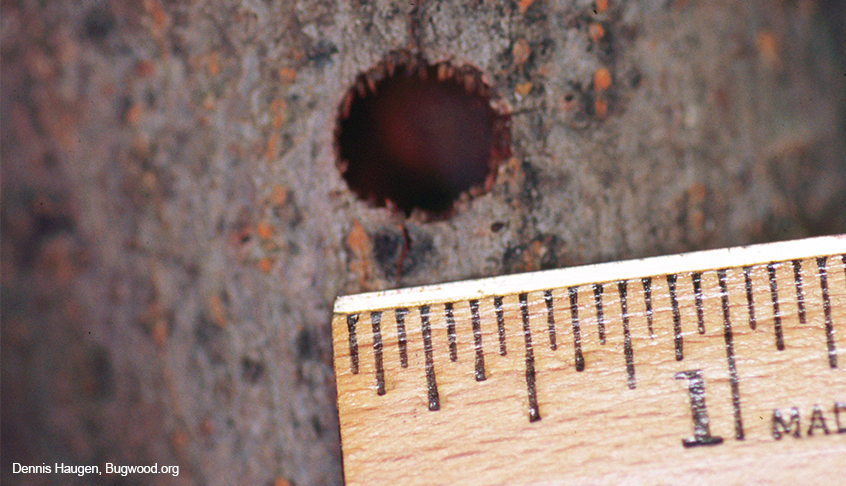
Each day, more than 1.8 billion wood pallets are in service in the United States, and billions more move across the globe. If you’re a global shipper, chances are you’re using wood packaging material (WPM), such as pallets, to ship your freight. While cost-effective, this seemingly harmless packaging material can quickly incur added cost for your supply chain if it’s found to be non-compliant with U.S. regulations.
Fortunately, these pitfalls can be avoided if you know what to look for, and how to comply with wood packaging material import requirements.
Sustainable wood packaging materials: A background
Over recent decades, increasing global trade has facilitated the spread of wood-burrowing insects to non-native countries, several of which have severely impacted local ecosystems and economies.
One such example is the Asian Longhorned Beetle (ALB). Able to live deep inside trees for most of a year, the ALB feeds on the inside of the tree to survive, creating large tunnels and holes that leave behind a sawdust-like material, eventually killing the tree it infests. Because they are difficult to detect, wood-burrowing insects like the ALB are easily and unknowingly transported in WPM.
Global concern spread in the 1990s when invasive insects like the Asian Longhorned Beetle were discovered in the United States and infestations began to spread. In some cases, entire species of trees in the United States were decimated by invasive insects in mere decades, costing homeowners an estimated $1-2 billion annually in extra expenses and lost property values.
These are just some of the very real concerns pertaining to wood packaging materials, and why many import regulations for WPM have been adopted by trading partners across the globe.

Adult Asian Longhorned Beetle tunneling in a tree.

A tree-lined Chicago street once infested with Asian Longhorned Beetle is replanted after eradication.
ISPM-15 adoption and requirements
In response to growing concerns with wood packaging materials, contracting parties of the International Plant Protection Convention (IPPC) adopted the International Standards for Phytosanitary Measures No. 15 (ISPM 15) in 2002, which describes requirements for heat and fumigation treatments of WPM used in international trade. Today, more than 100 countries around the world have adopted ISPM-15, including all major export markets worldwide.
The cost of non-compliant WPM
Non-compliant wood packaging materials can have many consequences for your supply chain that are often costly and time consuming. In the United States, any time a shipment is found to have live wood boring pests in the wood, the entire shipment is in violation of ISPM 15 and will be re-exported at the expense of the importer.
Common examples of non-compliant wood packaging materials include, but are not limited to:
- Insect damage
- Live pests (hitchhikers)
- No IPPC-compliant stamp
Extensive delays, hefty inspection fees, potential penalties, and in some cases, refusal of your shipment into the country, are just some examples of why WPM non-compliance is not worth the risk.
Exemptions to wood packaging material import requirements
Some articles considered to be of sufficiently low risk and exempted from WPM requirements in the United States include:
- WPM made entirely of Canadian origin wood when entering the United States
- Manufactured wood materials such as fiber board, whiskey and wine barrels, plywood, strand board, and veneer
- Pieces of wood that are less than 6 mm (0.24 in) in any dimension
- Alternative WPM, such as plywood, does not need to be stamped; however, composite units, such as crates made of both plywood and solid WPM, require the entire unit to be stamped on the plywood to indicate treatment
Best practices for compliant wood packaging materials
The good news is WPM violations can be prevented. Consider incorporating some of these WPM best practices into your supply chain.
Educate your supply chain team on WPM requirements:
- Physically inspect the WPM and reject pallets with signs of insect damage
- Know what pest infestation looks like: boreholes, bark, frass, sawdust, and larvae
- Verify that proper WPM stamp requirements are being met throughout your supply chain
Perform a cost-benefit analysis when considering WPM alternatives not subject to USDA regulation such as:
- Plywood or press board
- Plastic pallets
- Oriented strand board
- Hardboard
- Parallel strand lumber
- Synthetic foam
- Metal frames
- Inflated dunnage
- Masonite veneer
Establish WPM requirements with your WPM providers:
- Provide information to the exporter on the ISPM 15 standard to increase awareness, so they look for the official ISPM mark on the WPM and any signs that pests could be present
- Require ISPM 15 compliance in the contract
- Require exporters to inspect the WPM for signs of pests when delivered or before use
- Ask your WPM provider if they are ISPM 15 compliant and accredited. Review the certification provided by the exporting country’s national plant protection organization (NPPO).
- Provide websites and contact information to the exporter regarding how to become compliant. The NPPO will have information on the local program.
Communicate with your customs broker so they can help you stay on top of any changes with WPM requirements and address any concerns you have.
Sourcing wood packaging materials in other countries
Importers sourcing WPM in other countries should use packing materials from a registered and accredited manufacturer that has been heat treated or fumigated according to the IPPC regulations. Contact the NPPO of the shipment’s country of origin for more information.
What WPM best practices does your supply chain have in place?
Whether you’re new to wood packaging material requirements or have specific questions about WPM, C.H. Robinson can help. Connect with one of our Trusted Advisor® experts to get started.